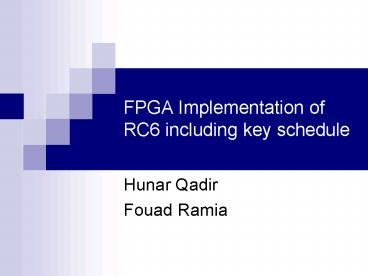FPGA Implementation of RC6 including key schedule PowerPoint PPT Presentation
1 / 18
Title: FPGA Implementation of RC6 including key schedule
1
FPGA Implementation of RC6 including key schedule
- Hunar Qadir
- Fouad Ramia
2
Introduction
- RC6 is a symmetric key block cipher derived from
RC5 - One of the five finalists chosen for AES
- Works on a block size of 128 bits
- Specified as RC6-w/r/b
- Supports key sizes of 64, 128, and 256 bits
3
Goal of our project
- Implementation of RC6 in hardware
- FPGA as the target technology
- Implementation of key schedule/generator in
addition to encryption/decryption - Study/compare the performance of our design
4
Motivation
- Why RC6?
- Security
- Simplicity
- Performance
- Why FPGAs?
- Higher performance than software solutions
- Reprogrammable (FPGA vs. ASICs)
5
RC6 Algorithm
- Key Schedule
- User supplies a key of b bytes
- 2r 4 words (w bits each) are derived and stored
in the array S 0, 2r 3 - Array is used in both encryption and decryption
6
RC6 Algorithm (continued)
- Encryption
- Plain text stored in four w-bit input registers
A, B, C, D - B B S 0
- D D S 1
- for i 1 to r do
- T (B X (2B 1)) ltltlt lg w
- u (D X (2D 1)) ltltlt lg w
- A ((A t) ltltlt u) S 2i
- C ((C u) ltltlt t) S 2i 1
- (A, B, C, D) (B, C, D, A)
- A A S 2r 2
- C C S 2r 3
- Figure taken from RC6 paper by Ron Rivest
7
RC6 Algorithm (continued)
- Decryption
- Cipher text stored in four w-bit input registers
A, B, C, D - C C S 2r 3
- A A S 2r 2
- for i r downto 1 do
- (A, B, C, D) (D, A, B, C)
- u (D X (2D 1)) ltltlt lg w
- t (B X (2B 1)) ltltlt lg w
- C ((C S 2i 1) gtgtgt t) u
- A ((A S 2i) gtgtgt u) t
- D D S 1
- B B S 0
8
Development Environment
- Use VHDL to simulate hardware implementation
- CAD tools used
- ALDEC Active HDL
- Synplify Pro 8.5 for synthesis
- Xilinx ISE 7.1 for implementation
- Selection of a target FPGA
- Xilinx Virtex XCV1000
9
RC6 Pin-out Diagram
10
RC6 Key Schedule Module
11
RC6 Core Module
12
RC6 Block diagram
13
Control Unit
14
Control Signals
15
Implementation results
- Min. Period (ns)
- 22.881
- Max. Frequency (MHz)
- 43.7
- Throughput Including key generation
- 27 Mbit/sec
- Throughput Encryption/Decryption only
- 266 Mbit/sec
16
Comparing FPGA with software implementations
RC6 Key setup Encryption Decryption
FPGA at 43.7 MHZ 188 cycles 4305 ns 21 cycles 480 ns 21 cycles 480 ns
ANSI C at 200 MHZ 2,350 cycles 11,800 ns 616 cycles 3080 ns 566 cycles 2830 ns
Java (JIT) at 200 MHZ 14,300 cycles 71,400 ns 1010 cycles 5050 ns 955 cycles 4775 ns
Assembly at 200 MHZ N/A 254 cycles 1270 ns 254 cycles 1270 ns
17
Comparing FPGA with software implementations
(continued)
18
Conclusion Future Work
- Pros and Cons of Key Schedule on board
Advantages Disadvantages
With Key Schedule No need to reload the Round keys every time the user changes the input Key 1- Lower throughput 2- More hardware resources
Without Key Schedule 1- Higher throughput 2- Less hardware resources Every time the input key is changed, the round keys must be reloaded to the FPGA
- Future Work Compute round keys on the fly

